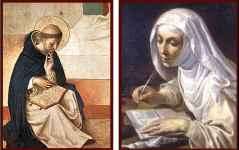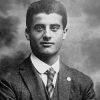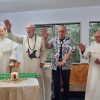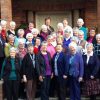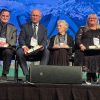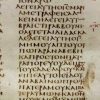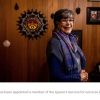Being Dominican
Over time we hope to interview a number of our Dominican Family members. It is fitting at this time when we celebrate 50 years since the start of the Second Vatican Council that we begin these interviews with one who was studying in Rome towards the end of this Council. She recalls that period in her life with great enthusiasm.
Sister Loreto went to Rome to attend Regina Mundi in October 1965. One of her great joys was to be in Rome during the final months of the Second Vatican Council. While Loreto’s year of study was cut short during the second half of the academic year by an attack of rheumatic fever, she has often spoken of this period as a very special time. Loreto was invited to share with us some high points of her Roman experience.
Loreto, how did you feel when you were invited to study in Rome?
When told by Mother M. David that I was to attend Regina Mundi along with a companion (who turned out to be S. M. Denise, now Roxane), I immediately replied “But, I don’t know enough to be going over there.” Mother M. David’s response was “But, you will, when you come home!” Before leaving, I attempted unsuccessfully, to cram some Italian, philosophy and scripture into my head!
The boat journey from home to England was exciting with the presence on board of Fr Ted Kennedy from Redfern, Sydney. He, Roxane and I often gathered in the ship’s lounge in the afternoons to study documents already emerging from the Council. We stimulated one another with many thoughts and possibilities. We stopped off in Colombo en route and because two of us had family links with Good Shepherd sisters, we enjoyed getting to know Good Shepherd sisters in a country then called ‘Ceylon’.
What were some highlights during your experience in Rome?
I just loved the magnificence of Rome. I would take a mirror into the Sistine chapel and wonder in amazement at Michelangelo’s ceiling. I also loved St Peter’s basilica where I spent many hours gazing at its structure and joining in prayer. I especially recall being in the great nave of St Peter’s when Pope Paul VI dramatically closed a large book in front of the assembled bishops and before the whole congregation solemnly pronouncing “No more anathemas!” I will never forget that moment. I was also in Rome when some of the later Council documents were promulgated and received by the bishops. While the documents were in Latin, I and several others would go to a small shop nearby where we could purchase English translations. I was so excited being able to read all this wonderful material and I got a real feeling for what was happening within the church at that time.
Other memories of that city included my arriving at ‘St Paul Outside-the-Walls’ and seeing Ian Paisley standing outside the basilica with the caption “Traitor!” on his apron. Paisley was signalling his disapproval of the meeting occurring in this church between Pope Paul VI and Archbishop Ramsey of Canterbury. Four hundred years of separation was being set aside to begin a journey towards Christian unity. Then, there were the homely, but also significant moments such as that when Bishop John Kavanagh of Dunedin sent a cab plus box of chocolates for Roxane and me to enjoy on a visit to the Tivoli Gardens. There were also the kindnesses I experienced when in hospital for six weeks. For example, Fr Jim Neilan (from Dunedin, and studying at the Alphonsianum) visited me most days travelling by Vespa to share post-Council stories. He also gave me a transistor radio (thanks to a nearby ‘flea market’) so that I could listen to the BBC. Then, there was an Irish sister, Sr Paul Mary who came to the hospital on many a morning to bring me communion. I was delighted to renew contact with her some years later in Ireland.
Are there any insights from the Second Vatican Council that have remained with you over the years?
Yes, two in particular stand out. The first concerns my understanding of “revelation.” Up until the Council, I had believed that God’s revelation to humanity had ended with the death of the last apostle. That was what we were taught. However, Vatican Two extended that vision. I began to realise that divine revelation was around me all of the time and I simply needed to be open to recognising the signs of God’s continuing presence in my life. I love that word ‘Presence.’ Ever since then, I have been trying to acknowledge God’s presence everywhere. I see my recognition of that presence as my response to divine revelation.
The second insight links to the sacraments, especially to the sacrament of the Anointing of the Sick. Having just studied Sacramental theology from an Irish Dominican, Finbar Ryan OP, I had begun to understand that the church now considered this sacrament (which I had always thought of as the sacrament for the dying) as fundamentally a sacrament of healing. Soon after Vatican Two I recall, during my illness, requesting this sacrament from a friar and his response was sadly “Sister, you are not dying!” I knew deep down that he was mistaken and was conscious that my understanding of sacramentality had happily been broadened.
In conclusion, is there anything more you want to add?
Yes, I want to recall the visit of Sisters M. Josephine and St Anne to Rome. We visited St Peter’s where Josephine told me that the statues of the apostles atop the basilica were apparently over twelve feet high. We were amazed. I was so glad to be with sisters from home in a special place alive with many memories. I could just drink in the beauty and recall my regular participation in ‘English’ Masses in one of the smaller chapels. I knew that I would never forget the beauty of the Pieta. While, sadly, I never completed my studies in Rome, because of my illness contracted during a visit to damp Siena, I will never forget the wonder and excitement of Rome. Those months were for me a time of deep blessing.
